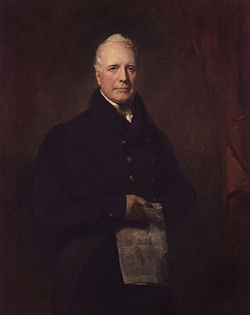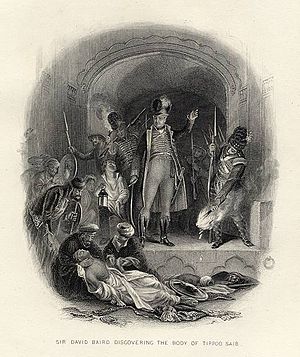- Sir David Baird, 1st Baronet
-
Sir David Baird, Bt 
Portrait by John Watson Gordon, c. 1825Born 6 December 1757
East Linton, East LothianDied 18 August 1829 (aged 71) Allegiance  United Kingdom
United KingdomService/branch  British Army
British ArmyRank General Commands held Ireland Battles/wars Second Anglo-Mysore War
Third Anglo-Mysore War
Fourth Anglo-Mysore War
French Revolutionary Wars
Peninsular WarAwards Knight Grand Cross of the Order of the Bath General Sir David Baird, 1st Baronet GCB (6 December 1757 – 18 August 1829) was a British military leader.
Contents
Military career
He was born at Newbyth House in Haddingtonshire, Scotland, the son of an Edinburgh merchant family,[1] and entered the British Army in 1772. He was sent to India in 1779 with the 73rd (afterwards 71st) Highlanders, in which he was a captain. Immediately on his arrival, Baird was attached to the force commanded by Sir Hector Munro, which was sent forward to assist the detachment of Colonel Baillie, threatened by Hyder Ali. In the action which followed the whole force was destroyed, and Baird, severely wounded, fell into the hands of the Mysore chief. The prisoners remained captive for over four years. Baird's mother, on hearing that her son and other prisoners were in fetters, is said to have remarked, "God help the chiel chained to our Davie." The bullet was not extracted from Baird’s wound until his release.
He was promoted to major in 1787, visited England in 1789, and purchased a lieutenant-colonelcy in 1790, returning to India the following year. He held a brigade command in the war against Tippoo Sultan, and served under Lord Cornwallis in the Seringapatam operations of 1792. He captured Pondicherry being promoted colonel in 1795. Baird served also at the Cape of Good Hope as a brigadier-general, and he returned to India as a major-general in 1798. In the last war against Tippoo in 1799 Baird was appointed to the senior brigade command in the army. At the successful assault of Seringapatam, Baird led the storming party, and soon took the stronghold where he had previously been a prisoner.
Disappointed that the command of the large contingent of the nizam was given to the then Colonel Arthur Wellesley, and that after the capture of the fortress the same officer obtained the governorship, Baird felt he had been treated with injustice and disrespect. He later received the thanks of parliament and of the Honourable East India Company for his gallant bearing on that important day, and a pension was offered him by the Company, which he declined, apparently in the hope of receiving the Order of the Bath from the government. General Baird commanded the Indian army which was sent in 1801 to co-operate with Ralph Abercromby in the expulsion of the French from Egypt. Wellesley was appointed second in command, but owing to ill-health did not accompany the expedition. Baird landed at Kosseir, conducted his army across the desert to Kena on the Nile, and then to Cairo. He arrived before Alexandria in time for the final operations.
On his return to India in 1802, he was employed against Sindhia, but being irritated at another appointment given to Wellesley he relinquished his command and returned to Europe. In 1804 he was knighted, and in 1805—1806, being by now a lieutenant-general, he commanded the expedition against the Cape of Good Hope with complete success, capturing Cape Town and forcing the Dutch general Janssens to surrender. But here again his usual ill luck attended him. Commodore Sir Home Popham persuaded Sir David to lend him troops for an expedition against Buenos Aires; the successive failures of operations against this place involved the recall of Baird early in 1807, though on his return home he was quickly re-employed as a divisional general in the Copenhagen expedition of 1807. During the bombardment of Copenhagen, Baird was wounded at Kongedybet by Karl Olsen, the 14 year old son of the local innkeeper at the time.
Shortly after his return, he was sent out to the Peninsular War in command of a considerable force which was sent to Spain to cooperate with Sir John Moore, to whom he was appointed second in command. It was Baird's misfortune that he was junior by a few days both to Moore and to Lord Cavan, under whom he had served at Alexandria, and thus never had an opportunity of a chief command in the field. At the Battle of Corunna he succeeded to the supreme command after Moore's death, but shortly afterwards his left arm was shattered, and the command passed to Sir John Hope. Once again thanked by parliament for his gallant services, he was made a Knight Grand Cross of the Bath and a baronet in 1809. Sir David married Miss Campbell-Preston, a Perthshire heiress, in 1810. He was not employed again in the field, and personal and political enmities caused him to be neglected and repeatedly passed over.
He was not given the full rank of general until 1814, and his governorship of Kinsale was given five years later. In 1820 he was appointed commander-in-chief in Ireland and made a Privy Counsellor for Ireland, but the command was soon reduced, and he resigned in 1822.
Popular culture
Baird appears as a character in the Richard Sharpe series of novels, focusing on his role in the 1799 Mysore campaign, and the 1807 expedition to Copenhagen. Baird is shown as hearty, bluff likeable man, and is friendly towards Sharpe. He is described as being able to both move within the high society. Though an officer, he was complimented to be fearless, he can outswear any sergeant and was as tough as an enlisted man. Though a high ranking officer. He leads from the front with the men.
Baird also appears as a commanding General in the naval fiction book "The Only Victor" by Douglas Reeman.[2] This is set just before Baird's successful campaign to capture Cape Town of which he eventually became the Governor.
Baird is one of several 17th and 18th century generals used as computer opponent identities in many computer adaptations of the board game Risk.
References
- ^ "Seringapatam sword". National Museums Scotland. http://www.nms.ac.uk/highlights/objects_in_focus/seringapatam_sword.aspx. Retrieved 2011-05-30.
- ^ The Only Victor [Book] ISBN 0099497697
 Chisholm, Hugh, ed (1911). "Baird, Sir David". Encyclopædia Britannica (11th ed.). Cambridge University Press.
Chisholm, Hugh, ed (1911). "Baird, Sir David". Encyclopædia Britannica (11th ed.). Cambridge University Press.
Resources
- Theodore Hook, Life of Sir David Baird.
- Leigh Rayment's List of Baronets
- thePeerage.com
Military offices Preceded by
Jan Willem Janssens
as Governor-General of the Cape Colony
(Dutch rule)Governor of the Cape Colony, acting
1806–1807Succeeded by
Henry George Grey, actingPreceded by
Richard WhyteColonel of the 24th (the 2nd Warwickshire) Regiment of Foot
1807–1829Succeeded by
Sir James Frederick LyonPreceded by
Sir George BeckwithCommander-in-Chief, Ireland
1820–1822Succeeded by
Sir Samuel AuchmutyBaronetage of the United Kingdom New creation Baronet
(of Newbyth)
1809–1829Succeeded by
David BairdCategories:- 1757 births
- 1829 deaths
- 71st Highlanders officers
- Baronets in the Baronetage of the United Kingdom
- British Army generals
- British Army personnel of the Napoleonic Wars
- British Army commanders of the Napoleonic Wars
- British military personnel of the Fourth Anglo-Mysore War
- Commander-in-Chief, Ireland
- Governors of the Cape Colony
- Knights Grand Cross of the Order of the Bath
- Members of the Privy Council of Ireland
- People from East Lothian
- South Wales Borderers officers
Wikimedia Foundation. 2010.

